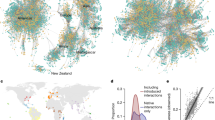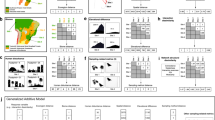Abstract
Recent studies on ecological networks have quantified the contribution of ecological, historical, and evolutionary factors on the structure of local communities of interacting species. However, the influence of species’ biogeographical traits, such as migratory habits or phylogeographical history, on ecological networks is poorly understood. Meta-networks, i.e., networks that cover large spatial extensions and include species not co-occurring locally, enable us to investigate mechanisms that operate at larger spatial scales such as migratory patterns or phylogeographical distributions, as well as indirect relationships among species through shared partners. Using a meta-network of hummingbird-plant interaction across Mexico, we illustrate the usefulness of this approach by investigating (1) how biogeographical and morphological factors associate with observed interactions and (2) how species-specific biogeographical characteristics associate with species’ network roles. Our results show that all studied hummingbird and plant species in the meta-network were interrelated, either directly or through shared partners. The meta-network was structured into modules, resulting from hummingbirds and plants interacting preferentially with subsets of species, which differed in biogeographical, and, to a lesser extent, morphological traits. Furthermore, migrants and hummingbirds from Nearctic, Transition, and widespread regions had a higher topological importance in the meta-network. Our study illustrates how meta-networks may contribute to our current knowledge on species’ biogeographical traits and biotic interactions, providing a perspective complementary to local-scale networks.




Similar content being viewed by others
References
Abrahamczyk S, Kessler M (2014) Morphological and behavioural adaptations to feed on nectar: how feeding ecology determines the diversity and composition of hummingbird assemblages. J Ornithol 156:333–347
Araújo MB, Luoto M (2007) The importance of biotic interactions for modelling species distributions under climate change. Glob Ecol Biogeogr 16:743–753
Araujo AC, Martín González AM et al (2018) Spatial distance and climate determine modularity in a cross-biomes plant-hummingbird interaction network in Brazil. J Biogeogr 45:1846–1858
Arizmendi MC, Berlanga H (2014) Colibríes de México y Norteamérica/Hummingbirds of Mexico and North America. CONABIO Mexico
Barber MJ (2007) Modularity and community detection in bipartite networks. Phys Rev E76:066102
Bascompte J, Jordano P, Melián CJ, Olesen JM (2003) The nested assembly of plant–animal mutualistic networks. Proc Natl Acad Sci 100:9383–9387
Bleiweiss R (1998) Origin of hummingbird faunas. Biol J Linn Soc 65:77–97
Brown JH, Bowers MA (1985) Community organization in hummingbirds: relationships between morphology and ecology. Auk 102:251–269
Cavender-Bares J, Kozak KH, Fine PV, Kembel SW (2009) The merging of community ecology and phylogenetic biology. Ecol Lett 12:693–715
Chacoff N, Resasco J, Vázquez DP (2017) Interaction frequency, network position, and the temporal persistence of interactions in a plant-pollinator network. Ecology 99:21–28
Dalsgaard B, Martín González AM, Olesen JM, Ollerton J, Timmermann A, Andersen LH, Tossas AG (2009) Plant-hummingbird interactions in the West Indies: floral specialisation gradients associated with environment and hummingbird size. Oecologia 159:757–766
Dalsgaard B, Magård E et al (2011) Specialization in plant-hummingbird networks is associated with species richness, contemporary precipitation and quaternary climate-change velocity. PLoS One 6:e25891
Dalsgaard B, Kennedy JD et al (2018) Trait evolution, resource specialisation and vulnerability to plant extinctions among Antillean hummingbirds. Proc R Soc B 285:20172754
Dormann CF (2012) Visualising bipartite networks and calculating some (ecological) indices. Package "bipartite"
Emer C, Galetti M, Pizo MA, Guimarães PR, Moraes S, Piratelli A, Jordano P (2018) Seed-dispersal interactions in fragmented landscapes – a metanetwork approach. Ecol Lett 21:484–493
Escalante P, Navarro AG, Peterson AT (1993) A geographic, historical and ecological analysis of land bird diversity in Mexico. In: Ramamoorthy TP, Bye R, Fa J, Lot A (eds) Biological diversity in Mexico: origins and distributions. Oxford University Press, New York, pp 281–307
Grant KA, Grant V (1968) Hummingbirds and their flowers. Columbia University Press
Hayfield T, Racine JS (2008) Nonparametric econometrics: the np package. Journal of statistical software 27(5). URL http://www.jstatsoft.org/v27/i05/
Hayfield T, Racine JS (2017) Nonparametric kernel smoothing methods for mixed data types. Package "np"
Halffter G (1987) Biogeography of the montane entomofauna of Mexico and Central America. Annu Rev Entomol 32:95–114
Heilmann-Clausen J, Maruyama PK, Bruun HH, Dimitrov D, Læssøe T, Frøslec TG, Dalsgaard B (2017) Citizen science data reveal ecological, historical and evolutionary factors shaping interactions between woody hosts and wood-inhabiting fungi. New Phytol 212:1072–1082
Kantsa A, Raguso RA, Dyer AG, Olesen JM, Tscheulin T, Petanidou T (2018) Disentangling the role of floral sensory stimuli in pollination networks. Nature Comm 9:1041
Lara C (2006) Temporal dynamics of flower use by hummingbirds in a highland temperate forest in Mexico. EcoScience 13:23–29
Licona-Vera Y, Ornelas JF (2014) Genetic, ecological and morphological divergence between populations of the endangered Mexican Sheartail hummingbird (Doricha eliza). PLoS ONE 9:e101870
Licona-Vera Y, Ornelas JF (2017) The conquering of North America: dated phylogenetic and biogeographic inference of migratory behavior in bee hummingbirds. BMC Evol Biol 17:126
Luna-Vega I, Morrone J, Alcántara Ayala O, Ornagista DE (2001) Biogeographical affinities among Neotropical cloud forests. Plant Syst Evol 228:229–239
Maglianesi MA, Blüthgen, Böhning-Gaese K, Schleuning M (2014) Morphological traits determine specialization and resource use in plant-hummingbird networks in the neotropics. Ecology 95:3325–3334
Maglianesi MA, Blüthgen, Böhning-Gaese K, Schleuning M (2015) Functional structure and specialization in three tropical plant-hummingbird interaction networks across an elevational gradient in Costa Rica. Ecography 38:1119–1128
Malpica A, Ornelas JF (2014) Postglacial northward expansion and genetic differentiation between migratory and sedentary populations of the broad-tailed hummingbird (Selasphorus platycercus). Mol Ecol 23:435–452
Marquitti FMD, Guimarães PR Jr, Pires MM, Bittencourt LF (2014) MODULAR: software for the autonomous computation of modularity in large network sets. Ecography 37:221–224
Martín González AM, Allesina S, Rodrigo A, Bosch J (2012) Drivers of compartmentalization in pollination networks. Oikos 121:2001–2013
Martín González AM, Dalsgaard B et al (2015) Themacroecology of phylogenetically structured hummingbird-plant networks. Glob Ecol Biogeogr 24:1212–1224
Maruyama PK, Vizentin-Bugoni J, Oliveira GM, Oliveira PE, Dalsgaard B (2014) Morphological and spatio-temporal mismatches shape a Neotropical savanna plant-hummingbird network. Biotropica 46:740–747
McGuire JA, Witt CC, Remsen JV Jr, Corl A, Rabosky DL, Altshuler DL, Dudley R (2014) Molecular phylogenetics and the diversification of hummingbirds. Curr Biol 24:910–916
Morrone JJ (2010) Fundamental biogeographic patterns across the Mexican Transition Zone: an evolutionary approach. Ecography 33:355–361
Morrone JJ, Márquez J (2001) Halffter’s Mexican Transition Zone, beetle generalised tracks, and geographical homology. J Biogeog 28:635–650
Morrone JJ, Escalante T, Rodríguez-Tapia G (2017) Mexican biogeographic provinces: map and shapefiles. Zootaxa 4277:277
Navarro SAG, Townsend Peterson A, Gordillo-Martínez A (2002) A Mexican case study on a centralised database from world natural history museums. Data Sci 1:45–53
Oksanen J (2017) Vegan: an introduction to ordination. Package "vegan"
Olesen JM, Bascompte J, Dupont YL, Jordano P (2007) The modularity of pollination networks. Proc Natl Acad Sci USA 104:19891–19896
Ornelas JF, Lara C (2015) Differential response to color task on resident and migratory hummingbirds: a field test. Ethol Ecol & Evol 27:257–378
Ornelas JF, González C, Espinosa delos Monteros A, Rodríguez-Gómez F, García-Feria LM (2014) In and out of Mesoamerica: temporal divergence of Amazilia hummingbirds pre-dates the orthodox account of the completion of the Isthmus of Panama. J Biogeogr 41:168–181
Ornelas JF, González de León S, González C, Licona-Vera Y, Ortiz-Rodriguez AE, Rodríguez-Gómez F (2015) Comparative palaeodistribution of eight hummingbird species reveal a link between genetic diversity and quaternary habitat and climate stability in Mexico. Folia Zool 64:245–258
Poisot T, Stouffer DB, Gravel D (2015) Beyond species: why ecological interactions. Oikos 124:243–251
Rech AR, Dalsgaard B, Sandel B, Sonne J, Svenning JC, Holmes N, Ollerton J (2016) The macroecology of animal versus wind pollination: ecological factors are more important than historical climate stability. Plant Ecol & Div 9:253–262
Ricklefs RE (1987) Community diversity: relative roles of local and regional processes. Science 235:167–171
Rodríguez-Gómez F, Gutiérrez-Rodríguez C, Ornelas JF (2013) Genetic, phenotypic and ecological divergence with gene flow at the Isthmus of Tehuantepec: the case of the azure-crowned hummingbird (Amazilia cyanocephala). J Biogeogr 40:1360–1373
Rzedowski J (1965) Relaciones geográficas y posibles orıgenes de la flora de México. Bol Soc Bot Mex 29:121–177
Rzedowski J (1992) Diversidad y orígenes de la flora fanerogámica de México. Ciencias 5:47–56
Stouffer DB, Bascompte J (2011) Compartmentalization increases food-web persistence. Proc Natl Acad Sci USA 108:3648–3652
Sonne J, Martín González AM et al (2016) High proportion of smaller ranged hummingbird species coincides with ecological specialization across the Americas. Proc R Soc B 283:20152512
Stiles FG (1978) Ecological and evolutionary implications of bird pollination. Am Zool 18:715–727
Stiles FG (1981) Geographical aspects of bird-flower coevolution, with particular reference to Central America. Ann Miss Bot Gard 68:323–351
Thuiller W, Münkemüller T, Lavergne S, Mouillot D, Mouquet N, Schiffers K, Gravel D (2013) A roadmap for integrating eco-evolutionary processes into biodiversity models. Ecol Lett 16:94–105
Tylianakis JM, Laliberté E, Nielsen A, Bascompte J (2010) Conservation of species interaction networks. Biol Conserv 143:2270–2279
Vázquez DP, Blüthgen N, Cagnolo L, Chacoff NP (2009) Uniting pattern and process in plant–animal mutualistic networks: a review. Annals Bot 103:1445–1457
Vizentin-Bugoni J, Maruyama PK, Sazima M (2014) Processes entangling interactions in communities: forbidden links are more important than abundance in a hummingbird–plant network. Proc Royal Soc B Biol Sci 281:20132397
Weinstein BG, Graham CH, Parra JL (2017) The role of environment, dispersal and competition in explaining reduced co-occurrence among related species. PLoS One 12:e0185493
Zanata T, Dalsgaard B et al (2017) Global patterns of interaction specialization in bird-flower networks. J Biogeogr 44:1891–1910
Acknowledgements
We thank Sven Thatje, Tobias Roth, and three anonymous referees for helpful comments on a previous version of the manuscript. AMMG is supported through a Marie Skłodowska-Curie Individual Fellowship (H2020-MSCA-IF-2015-704409). AMMG and BD thank the Danish National Research Foundation for its support of the Center for Macroecology, Evolution and Climate (Grant number DNRF96). CL thanks the Secretaría de Investigación of Universidad Autónoma de Tlaxcala for the scholarship awarded. Verónica Mendiola-Islas provided logistical support during the revision of hummingbird-plant networks.
Author information
Authors and Affiliations
Corresponding author
Additional information
Communicated by: Sven Thatje
Electronic supplementary material
ESM 1
(DOC 315 kb)
Rights and permissions
About this article
Cite this article
Martín González, A.M., Ornelas, J.F., Dalsgaard, B. et al. Meta-networks for the study of biogeographical traits in ecological networks: the Mexican hummingbird-plant assemblage. Sci Nat 105, 54 (2018). https://doi.org/10.1007/s00114-018-1578-5
Received:
Revised:
Accepted:
Published:
DOI: https://doi.org/10.1007/s00114-018-1578-5




